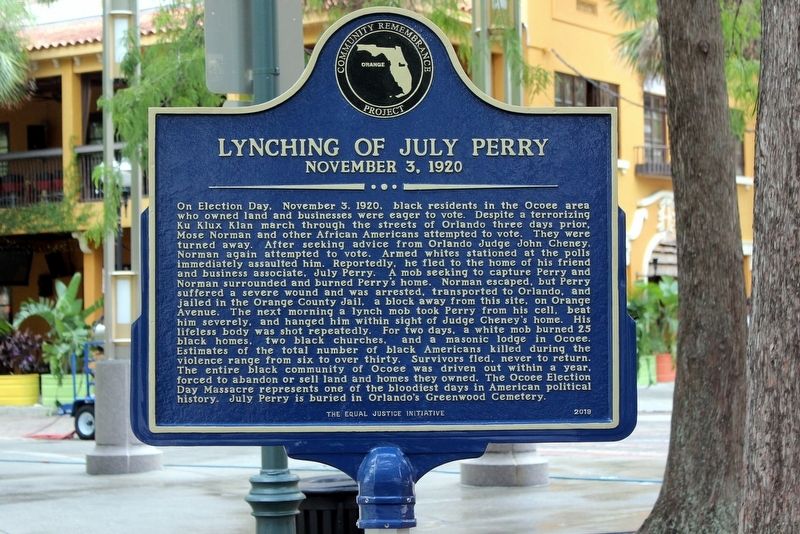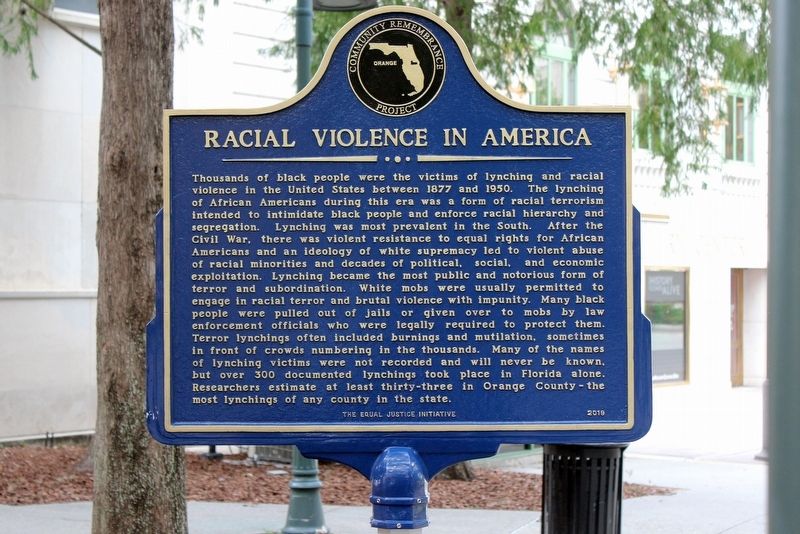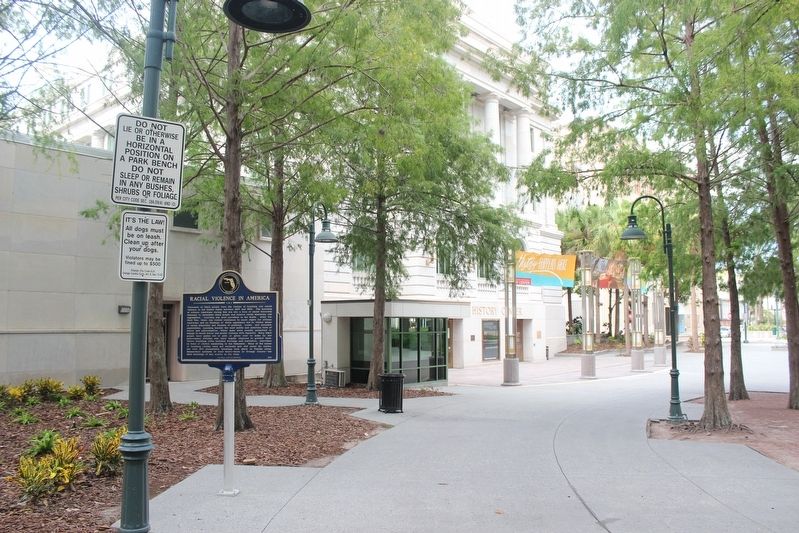Orlando in Orange County, Florida — The American South (South Atlantic)
Lynching of July Perry / Racial Violence in America
November 3, 1920
— Community Remembrance Project —
November 3, 1920
On Election Day, November 3, 1920, black residents in the Ocoee area who owned land and businesses were eager to vote. Despite a terrorizing Ku Klux Klan march through the streets of Orlando three days earlier, Mose Norman and other African Americans attempted to vote. They were turned away. After seeking advice from Orlando Judge John Cheney, Mr. Norman again attempted to vote. Armed white men stationed at the polls immediately assaulted him. He reportedly fled to the home of his friend and business associate, July Perry. A mob seeking to capture Mr. Perry and Mr. Norman surrounded and burned Mr. Perry's home. Mr. Norman escaped, but Mr. Perry was severely wounded. He was arrested, taken to Orlando, and locked in the Orange County Jail. The next morning, a lynch mob took Mr. Perry from his cell, brutally beat him, and hanged him within sight of Judge Cheney's home. His lifeless body was shot repeatedly. Over the next two days, a white mob burned 25 black homes, two black churches, and a masonic lodge in Ocoee. Estimates of the total number of black Americans killed during the violence range from six to over 30. Survivors fled, never to return. The entire black community of Ocoee was driven out within a year, forced to abandon or sell land and homes they owned. The Ocoee Election Day Massacre represents one of the bloodiest days in American political history. July Perry is buried in Orlando's Greenwood Cemetery.
Thousands of black people were the victims of lynching and racial violence in the United States between 1877 and 1950. The lynching of African Americans during this era was a form of racial terrorism intended to intimidate black people and enforce racial hierarchy and segregation. Lynching was most prevalent in the South, including Alabama, Arkansas, Florida, Georgia, Kentucky, Louisiana, Mississippi, North Carolina, South Carolina, Tennessee, Texas, and Virginia. After the Civil War, violent resistance to equal rights for African Americans and an ideology of white supremacy led to violent abuse of racial minorities and decades of political, social, and economic exploitation. Lynching became the most public and notorious form of terror and subordination. White mobs were usually permitted to engage in racial terror and brutal violence with impunity. Many black people were pulled out of jails or given over to mobs by law enforcement officials who were legally required to protect them. Terror lynchings often included burning and mutilation, sometimes in front of crowds numbering in the thousands. In response to this racial terror and violence, millions of black people fled the South and could never return, which deepened the anguish and pain of lynching. Many of the names of lynching victims were not recorded and will never be known, but over 300 documented lynchings took place in Florida alone. Researchers estimate at least 33 in Orange County — the most lynchings of any county in the state.
Erected 2019 by the Equal Justice Initiative.
Topics and series. This historical marker is listed in these topic lists: African Americans • Civil Rights. In addition, it is included in the Lynching in America series list. A significant historical date for this entry is November 3, 1920.
Location. 28° 32.566′ N, 81° 22.683′ W. Marker is in Orlando, Florida, in Orange County. Marker is at the intersection of East Central Boulevard and Court Avenue, on the right when traveling west on East Central Boulevard. Located in front of the Orange County Regional History Center in downtown Orlando. Touch for map. Marker is at or near this postal address: 65 East Central Blvd, Orlando FL 32801, United States of America. Touch for directions.
Other nearby markers. At least 8 other markers are within walking distance of this marker. Orange County Courthouse (a few steps from this marker); Orlando’s Round Building (within shouting distance of this marker); Orange County 9-11 Memorial (within shouting distance of this marker); Votes For Women
(about 300 feet away, measured in a direct line); The Cathedral Church of Saint Luke (about 600 feet away); Rosalind Club (about 700 feet away); Orlando and Tainan, Sister Cities (approx. 0.2 miles away); Linton E. Allen Memorial Fountain (approx. 0.2 miles away). Touch for a list and map of all markers in Orlando.
Credits. This page was last revised on October 2, 2022. It was originally submitted on July 30, 2019, by Tim Fillmon of Webster, Florida. This page has been viewed 928 times since then and 76 times this year. Photos: 1, 2, 3. submitted on July 30, 2019, by Tim Fillmon of Webster, Florida. • Bill Pfingsten was the editor who published this page.


